Linux-powered Robots Quick Reference Guide
Dec 5, 2003 — by LinuxDevices Staff — from the LinuxDevices Archive — 206 viewsThe robots are coming, the robots are coming . . .
According to a fascinating article at TechNewsWorld, Linux is poised to play a central role in an emerging industry that many expect to overtake the PC industry in size: robotics. Japan is currently driving robot innovation, according to the article, impelled by a looming labor shortage. Consumer robots like the Sony Aibo and Honda Asimo make headlines, but ubiquitous, cheap, and practical utility robots are what most Japanese robot makers are focused on, and “carmaker Honda believes that robots will become its most important business,” according to the article.
This exclusive LinuxDevices.com “quick reference guide” offers an interesting glimpse into of some Linux-powered robots currently available or near production, and provides an extensive reading list with further information on Linux in robotics.
We plan to update this Guide frequently, so be sure to check back periodically for the latest info.
 Neuronics Katana Robotic Arm — Nov. 24, 2008 — Neuronics's Katana Robotic Arm is aimed at industry, production, and research applications, and runs Linux with Xenomai hard real time extensions on a Freescale MPC5200-based control board. The Katana Robotic Arm is typically used for handling, measurement, or testing applications in assembly, production, and laboratory automation.
Neuronics Katana Robotic Arm — Nov. 24, 2008 — Neuronics's Katana Robotic Arm is aimed at industry, production, and research applications, and runs Linux with Xenomai hard real time extensions on a Freescale MPC5200-based control board. The Katana Robotic Arm is typically used for handling, measurement, or testing applications in assembly, production, and laboratory automation.
 Wany Robotics PeKeeII — Aug. 21, 2008 — This Linux-based sensor robot from France-based Wany Robotics is based on mini-ITX-based computers and is aimed at educational and R&D applications. The PeKeeII robot comes in two versions: Advanced (based on a Via C3) or Ultimate (Intel Core 2 Duo), and offer sensor telemetry, and with the Ultimate model, ultrasound and laser detection as well.
Wany Robotics PeKeeII — Aug. 21, 2008 — This Linux-based sensor robot from France-based Wany Robotics is based on mini-ITX-based computers and is aimed at educational and R&D applications. The PeKeeII robot comes in two versions: Advanced (based on a Via C3) or Ultimate (Intel Core 2 Duo), and offer sensor telemetry, and with the Ultimate model, ultrasound and laser detection as well.
 NICTA/UNSW Robo-Clarinet — Jun. 20, 2008 — Developed by the Australian research group NICTA and the University of New South Wales (UNSW), the clarinet-playing robot runs Linux on the Gumstix ARM PXA270-based Verdex board, clocked at 600MHz. The “Robo-Clarinet” won first prize at the Artemis Music Orchestra competition for autonomous, embedded musical instrument performances.
NICTA/UNSW Robo-Clarinet — Jun. 20, 2008 — Developed by the Australian research group NICTA and the University of New South Wales (UNSW), the clarinet-playing robot runs Linux on the Gumstix ARM PXA270-based Verdex board, clocked at 600MHz. The “Robo-Clarinet” won first prize at the Artemis Music Orchestra competition for autonomous, embedded musical instrument performances.
 Hanson Robotics Zeno — Oct. 02, 2007 — Developed by Hanson Robotics, “Zeno” is a robotic boy with two brains: a physical brain that runs Linux and a verbal brain that runs Windows XP. The 17-inch, 4.5-pound humanoid robot is still in prototype form, but can speak, learn, interact with its surroundings, and even recognize faces.
Hanson Robotics Zeno — Oct. 02, 2007 — Developed by Hanson Robotics, “Zeno” is a robotic boy with two brains: a physical brain that runs Linux and a verbal brain that runs Windows XP. The 17-inch, 4.5-pound humanoid robot is still in prototype form, but can speak, learn, interact with its surroundings, and even recognize faces.
 Ugobe Pleo — Sep. 13, 2007 — Ugobe's Pleo is an autonomous replica of a week-old Kamarasuarus dinosaur with a LifeOS that is rumored to be based on Linux. The $350, foot-tall device is not remotely controllable, but designed to imitate life by learning from its environment, showing emotion, and interacting with the animals around it.
Ugobe Pleo — Sep. 13, 2007 — Ugobe's Pleo is an autonomous replica of a week-old Kamarasuarus dinosaur with a LifeOS that is rumored to be based on Linux. The $350, foot-tall device is not remotely controllable, but designed to imitate life by learning from its environment, showing emotion, and interacting with the animals around it.
 Axion Racing Spirit — Aug. 09, 2007 — An autonomous vehicle that is said to have driven Colorado's Pikes Peak is equipped with a Sony PS3 running Yellow Dog's PS3 Linux and software that helps it “quickly examine information from a RGB road finding camera.” Axion Racing's “Spirit” UAV (unmanned, autonomous vehicle) is built on a 1994 Jeep Grand Cherokee, and includes Dell servers, SICK laser finders, Bumblebee stereo cameras, and FLIR infrared cameras, all guided by twin Navcom Starfire GPS units.
Axion Racing Spirit — Aug. 09, 2007 — An autonomous vehicle that is said to have driven Colorado's Pikes Peak is equipped with a Sony PS3 running Yellow Dog's PS3 Linux and software that helps it “quickly examine information from a RGB road finding camera.” Axion Racing's “Spirit” UAV (unmanned, autonomous vehicle) is built on a 1994 Jeep Grand Cherokee, and includes Dell servers, SICK laser finders, Bumblebee stereo cameras, and FLIR infrared cameras, all guided by twin Navcom Starfire GPS units.
 TU Darmstadt “der neue Roboter” — Jul. 05, 2007 — The “der neue Roboter” (the new robot), which is pictured on the right next to the Aldebaran Nao, has a canid design similar to the Sony AIBO, but unlike the AIBO, it runs Linux. The der neue Roboter was co-developed by the Technical University of Darmstadt (TU Darmstadt) and the Hajime Research Institute.
TU Darmstadt “der neue Roboter” — Jul. 05, 2007 — The “der neue Roboter” (the new robot), which is pictured on the right next to the Aldebaran Nao, has a canid design similar to the Sony AIBO, but unlike the AIBO, it runs Linux. The der neue Roboter was co-developed by the Technical University of Darmstadt (TU Darmstadt) and the Hajime Research Institute.
 Trek Aerospace Oviwun — Apr. 02, 2007 — This Trek Aerospace designed unmanned aerial vehicle (UAV) uses Debian Linux and open-source flight control software to achieve vertical take-off and landing (VTOL). The Oviwun weighs about six pounds, fits in a backpack, and includes a GPS system that enables autonomous flight and position control.
Trek Aerospace Oviwun — Apr. 02, 2007 — This Trek Aerospace designed unmanned aerial vehicle (UAV) uses Debian Linux and open-source flight control software to achieve vertical take-off and landing (VTOL). The Oviwun weighs about six pounds, fits in a backpack, and includes a GPS system that enables autonomous flight and position control.
 Aldebaran Nao — Feb. 26, 2007 — The Aldebaran Nao is a Linux-powered humanoid robot that also runs software from the open source Universal Real-time Behaviour Interface (URBI) project, enabling users to program Nao's behavior, emotional expressions, speech synthesizer, and collect data from its onboard video camera and other sensors. Nao stands 21.6 inches tall, implements 23 degrees of freedom, including gripping hands, and can be controlled via WiFi.
Aldebaran Nao — Feb. 26, 2007 — The Aldebaran Nao is a Linux-powered humanoid robot that also runs software from the open source Universal Real-time Behaviour Interface (URBI) project, enabling users to program Nao's behavior, emotional expressions, speech synthesizer, and collect data from its onboard video camera and other sensors. Nao stands 21.6 inches tall, implements 23 degrees of freedom, including gripping hands, and can be controlled via WiFi.
 K-Team Khepera III — Dec. 8, 2006 — A third-generation model in K-Team's flagship “Khepera” line, the Khepera III adds floor-roving capabilities, the better to support experiments in swarm behavior, K-Team says. It runs Linux on an optional ARM-powered add-in card.
K-Team Khepera III — Dec. 8, 2006 — A third-generation model in K-Team's flagship “Khepera” line, the Khepera III adds floor-roving capabilities, the better to support experiments in swarm behavior, K-Team says. It runs Linux on an optional ARM-powered add-in card.
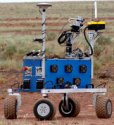 Nasa Lunar lander training robots — Sep. 14, 2006 — Two Linux-based lunar rovers were created as part of a NASA project tasked with developing extra-vehicular activity (EVA) hardware and procedures for planetary surface exploration.
Nasa Lunar lander training robots — Sep. 14, 2006 — Two Linux-based lunar rovers were created as part of a NASA project tasked with developing extra-vehicular activity (EVA) hardware and procedures for planetary surface exploration.
 Whitebox Robotics 914 PC-Bot — Aug. 7, 2006 — A mobile robot that runs Linux, and is based on standard, modular PC components, interfaces, and bays, the 914 PC Bot is sort of a PC on motorized wheels.
Whitebox Robotics 914 PC-Bot — Aug. 7, 2006 — A mobile robot that runs Linux, and is based on standard, modular PC components, interfaces, and bays, the 914 PC Bot is sort of a PC on motorized wheels.
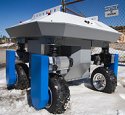 Mobile Robots (formerly ActivMedia) Seekur — Aug. 1, 2006 — An all-weather, indoor/outdoor Linux-ready mobile robot that targets “intelligent navigation” applications, such as laser mapping, the nimble, “holonomic” Seekur offers space, power, and networking for up to five EBX form-factor embedded PCs, and is available with a variety of sensor options.
Mobile Robots (formerly ActivMedia) Seekur — Aug. 1, 2006 — An all-weather, indoor/outdoor Linux-ready mobile robot that targets “intelligent navigation” applications, such as laser mapping, the nimble, “holonomic” Seekur offers space, power, and networking for up to five EBX form-factor embedded PCs, and is available with a variety of sensor options.
 Aldebaran Robots humanoid household service robots — Jul. 1, 2006 — A French start-up created to build autonomous, easily programmable, affordable humanoid robots has emerged from stealth mode. Aldebaran Robotics, of Paris, expects to ship its first producta humanoid household service robot running Linuxin early 2007.
Aldebaran Robots humanoid household service robots — Jul. 1, 2006 — A French start-up created to build autonomous, easily programmable, affordable humanoid robots has emerged from stealth mode. Aldebaran Robotics, of Paris, expects to ship its first producta humanoid household service robot running Linuxin early 2007.
 Robosoft RobuROC autonomous vehicle — Jul. 1, 2006 — A six-wheeled outdoor autonomous vehicle aimed at reducing human risks in reconnaissance, monitoring, and safety operations, the RobuROC 6 from French cleanliness robot specialist Robosoft runs real-time Linux. It supports a variety of add-on modules, and is user-programmable for complex missions, the company says.
Robosoft RobuROC autonomous vehicle — Jul. 1, 2006 — A six-wheeled outdoor autonomous vehicle aimed at reducing human risks in reconnaissance, monitoring, and safety operations, the RobuROC 6 from French cleanliness robot specialist Robosoft runs real-time Linux. It supports a variety of add-on modules, and is user-programmable for complex missions, the company says.
 HRP-2M Choromet — Jul. 1, 2006 — A low-cost, user-programmable humanoid robot targeting educational and research applications, the HRP-2m Choromet was created by four companies, and uses technology from Japan's National Institute of Advanced Industrial Science and Technology (AIST). It is user-programmable thanks to open software running on a user-space real-time Linux implementation.
HRP-2M Choromet — Jul. 1, 2006 — A low-cost, user-programmable humanoid robot targeting educational and research applications, the HRP-2m Choromet was created by four companies, and uses technology from Japan's National Institute of Advanced Industrial Science and Technology (AIST). It is user-programmable thanks to open software running on a user-space real-time Linux implementation.
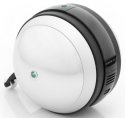 Sony Ericsson ROB-1 — Mar. 10, 2005 — The ROB-1 is a yo-yo-sized robot that can be controlled from certain mobile phones. Compatible phones can display and capture images from its VGA camera.
Sony Ericsson ROB-1 — Mar. 10, 2005 — The ROB-1 is a yo-yo-sized robot that can be controlled from certain mobile phones. Compatible phones can display and capture images from its VGA camera.
 Shanghai JiaoTong University's soccer-playing robots — Jan. 21, 2005 — An RTLinux-powered robot that placed fifth in the most recent RoboCup competition.
Shanghai JiaoTong University's soccer-playing robots — Jan. 21, 2005 — An RTLinux-powered robot that placed fifth in the most recent RoboCup competition.
 Michael's Robot — Jan. 18, 2005 — A Linux robot with a publicly accessible ssh account, allowing Linux hackers to write or modify programs that control the device. Michael's robot was created by Michael Shiloh, an electrical engineer who has worked with the Survival Research Laboratories.
Michael's Robot — Jan. 18, 2005 — A Linux robot with a publicly accessible ssh account, allowing Linux hackers to write or modify programs that control the device. Michael's robot was created by Michael Shiloh, an electrical engineer who has worked with the Survival Research Laboratories.
 ActivMedia Patrolbot — Aug. 26, 2004 — Embedded Linux and a high-end Versalogic single board computer (SBC) form the brain behind ActivMedia's new $30K “PatrolBot,” which ActivMedia calls “the first fully autonomous robotic surveillance and monitoring system available off-the shelf.” The device runs an unspecified version of embedded Linux on a VersaLogic VSBC-8, a Pentium III based EBX-compliant single board computer. PatrolBot features include laser, sonar, twin shaft encoders, gyroscopic correction system, and bump sensors.
ActivMedia Patrolbot — Aug. 26, 2004 — Embedded Linux and a high-end Versalogic single board computer (SBC) form the brain behind ActivMedia's new $30K “PatrolBot,” which ActivMedia calls “the first fully autonomous robotic surveillance and monitoring system available off-the shelf.” The device runs an unspecified version of embedded Linux on a VersaLogic VSBC-8, a Pentium III based EBX-compliant single board computer. PatrolBot features include laser, sonar, twin shaft encoders, gyroscopic correction system, and bump sensors.
 OAP open robot reference design — Nov. 5, 2003 — “Have you ever dreamed of building your own Linux-based droid that could roam around your home autonomously, intelligently obeying your commands?” asks Dafydd Walters. “You may now be able to finally fulfill your dream.” Walters founded and leads the Open Automaton Project (OAP), which aims to help enthusiasts assemble an intelligent mobile robot with stereo vision and state-of-the-art PC mainboard technologyfor about the cost of a good PC. See bigger pictures of OAP and learn about its sonar, IR, wireless, and stereo vision subsystems in our fully detailed article, complete with system block diagram.
OAP open robot reference design — Nov. 5, 2003 — “Have you ever dreamed of building your own Linux-based droid that could roam around your home autonomously, intelligently obeying your commands?” asks Dafydd Walters. “You may now be able to finally fulfill your dream.” Walters founded and leads the Open Automaton Project (OAP), which aims to help enthusiasts assemble an intelligent mobile robot with stereo vision and state-of-the-art PC mainboard technologyfor about the cost of a good PC. See bigger pictures of OAP and learn about its sonar, IR, wireless, and stereo vision subsystems in our fully detailed article, complete with system block diagram.
 Smart Robots SR4 autonomous mobile robot — May. 12, 2003 — This Linux-powered robot platform can travel at a speed of approximately 1.5 ft/sec. It can communicate with other S4s as well as people, via 2-way emails and pages hosted on its built-in web server.
Smart Robots SR4 autonomous mobile robot — May. 12, 2003 — This Linux-powered robot platform can travel at a speed of approximately 1.5 ft/sec. It can communicate with other S4s as well as people, via 2-way emails and pages hosted on its built-in web server.
 Wakamaru — Apr. 22, 2003 — This 3.3 foot tall, 60 pound Linux-powered robot is described as the first human-size robot capable of providing companionship or functioning as a caretaker and house sitter. The battery-operated robot moves about on wheels and recharges itself when its batteries run low. Wakamaru is said to be capable of conducting simple conversation using a 10,000 word vocabulary, and finding (and following) faces and movements using face recognition technology.
Wakamaru — Apr. 22, 2003 — This 3.3 foot tall, 60 pound Linux-powered robot is described as the first human-size robot capable of providing companionship or functioning as a caretaker and house sitter. The battery-operated robot moves about on wheels and recharges itself when its batteries run low. Wakamaru is said to be capable of conducting simple conversation using a 10,000 word vocabulary, and finding (and following) faces and movements using face recognition technology.
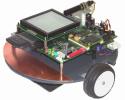 Spif mobile robot — Feb. 7, 2003 — This Linux-powered mobile robot can serve as a powerful test-bed for embedded real-time application experimentation. It boots Linux 2.4.19 from either Flash, DiskOnKey, or 802.11 wireless. The hardware board structure and size have been designed to make it easy to add new sensors and actuators, allowing powerful customization and limitless experimentation.
Spif mobile robot — Feb. 7, 2003 — This Linux-powered mobile robot can serve as a powerful test-bed for embedded real-time application experimentation. It boots Linux 2.4.19 from either Flash, DiskOnKey, or 802.11 wireless. The hardware board structure and size have been designed to make it easy to add new sensors and actuators, allowing powerful customization and limitless experimentation.
 Fujitsu HOAP-1 — Sep. 11, 2001 — Weighing 6 kg and standing 48 cm tall, the light and compact HOAP-1 miniature humanoid robot and accompanying simulation software can be used for developing motion control algorithms in such areas as two-legged walking, as well as in research on human-to-robot communication interfaces. This one also runs RTLinux.
Fujitsu HOAP-1 — Sep. 11, 2001 — Weighing 6 kg and standing 48 cm tall, the light and compact HOAP-1 miniature humanoid robot and accompanying simulation software can be used for developing motion control algorithms in such areas as two-legged walking, as well as in research on human-to-robot communication interfaces. This one also runs RTLinux.
 NASA Personal Satellite Assistant — Jul. 25, 2001 — NASA's Ames Research Center is building a “personal satellite assistant”, powered by a Pentium III with the Linux operating system, to help out astronauts on space shuttle and International Space Station (ISS) missions.
NASA Personal Satellite Assistant — Jul. 25, 2001 — NASA's Ames Research Center is building a “personal satellite assistant”, powered by a Pentium III with the Linux operating system, to help out astronauts on space shuttle and International Space Station (ISS) missions.
 Isamu — Jul. 20, 2001 — This jumbo-sized humanoid robot, stands 53 inches tall, weighs 121 pounds, and walks at over one mile per hour. Not only that, Isamu climbs up and down stairs, carries 4-pound objects in its hand-like grippers, and even recognizes human faces via its dual-camera stereo vision system. Oh, and Isamu has a “brain” that consists of a dual-Pentium computer running RTLinux.
Isamu — Jul. 20, 2001 — This jumbo-sized humanoid robot, stands 53 inches tall, weighs 121 pounds, and walks at over one mile per hour. Not only that, Isamu climbs up and down stairs, carries 4-pound objects in its hand-like grippers, and even recognizes human faces via its dual-camera stereo vision system. Oh, and Isamu has a “brain” that consists of a dual-Pentium computer running RTLinux.
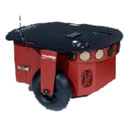 ActivMedia Mobile Robot — Feb. 22, 2000 — ActivMedia's Pioneer 2 mobile robot is a popular platform for education, research, prototyping, exhibits, and robotic projects. The device contains a Pentium-based EBX form-factor single-board computer running Linux, which is used for high-level communications and control functions.
ActivMedia Mobile Robot — Feb. 22, 2000 — ActivMedia's Pioneer 2 mobile robot is a popular platform for education, research, prototyping, exhibits, and robotic projects. The device contains a Pentium-based EBX form-factor single-board computer running Linux, which is used for high-level communications and control functions.
Robot profiles and news
- Linux well-represented at DARPA robot vehicle challenge
- Linux-powered humanoid robot on sale Friday
- Meet Wakamaru, the Linux-powered humanoid robot
- Linux-based mobile humanoid robot to debut in Japan (Wakamaru)
- Embedded Linux drives PatrolBot surveillance robot
- First word of second coming of Fujitsu Linux-powered robot
- Humanoid robot goes to work on Linux [ZDNet]
- Linux robot man treks into Europe [ZDNet]
- Isamu comes to Milano!
- Fujitsu opens up Linux-based humanoid robot
- Fujitsu miniature humanoid robot runs RTLinux
- Meet Isamu, the humanoid robot (with RTLinux inside)
- Linux-based killer robot at Battlebots? Not quite!
Robot standards and platforms
- Updated review of robotics software platforms
- Meet OAP — an open robot reference design project
- Free mobile robot design
- Watch out, the Centibots are invading LinuxWorld
- More details on Intel's XScale/Linux robotics platform
- Linux drives spiffy mobile robot test-bed
- 'First-of-a-kind' Robot Developer Kit supports Linux and open APIs
- Startup's “open” software platform for personal robotics runs Linux
Robot technology
- Miniature Linux-based XScale SBC for mobile robotics
- Linux enables first robot-to-robot email exchange
- Linux in robotics
- Linux-powered mobile robot communicates by email, webserver
- Intel researchers combine mobile robots, wireless, silicon, Linux
- Intel gives PCs eyes with open-source software
Post your comments and questions about this article here
This article was originally published on LinuxDevices.com and has been donated to the open source community by QuinStreet Inc. Please visit LinuxToday.com for up-to-date news and articles about Linux and open source.